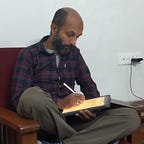Learnings from a recent session with youth : Pedagogical reflections
Some of my learnings from a recent session for youth on the marriage liturgy and its impact on life:
1. Participant-centred learning
Participants bring knowledge of their world into the session. They are not blank slates. Therefore simple prompts, can elicit meaningful resources from their memories, personal experience and knowledge that can be useful in making the session rich and valuable in terms of learnings and gaining perspective.
2. Collaborative learning
Gone are the days when one sat in the confines of one’s studyroom/table alone. All major research programmes have been collaborative (eve if not acknowledged so!) for a very long time. In youth groups collaborative learnings enables participants from various walks of life to learn to work together and from one another.
3. Learning through problem-solving
The session was put-forth in the form of a problem-solving format. The participants had to be sort of detectives so that they could piece the clues together. There is no problem as such. So, you frame the learning material in the form of a problem-solving / mystery mode that enables participants to piece together their knowledge and learn through trial and error. Participants enjoy the feeling of having solved problems and become ready to solve another one, there by contributing to an ‘I/we can’ feeling that is conducive for learning the material at hand.
4. Gamification
Probably this is the most misunderstood part in the teaching process. Even companies like Kahoot, DuoLingo, Coursera, etc. have been using some form of gamification by adding points, bonuses, prizes, etc. in order to foster interest and make participants remain engaged with the material at hand. In our session, we offered points for completing levels, and early-bird prizes for completing early. Point announcements at various stages helped make the learning more competitive. This competitiveness is merely an encouragement to engage with the liturgical material and the Bible, which were the material they were learning.
5. Multi-lingual communication
This session bypassed the common tendency in our community to side with English or Malayalam. The reality of the students — bilingual nature — are brought in as a resource and a blessing in disguise. The participants get to inhabit both worlds in the same time. When applied in youth sessions in Delhi churches such as Mayur Vihar, Ghaziabad and Parparganj, the communications would flow seamlessly in an out of three languages — Hindi (heart language), English (official communication language), Malayalam (liturgical language and mother tongue).
6. Resource person’s Homework
This type of session requires the resource person to do enough homework by preparing worksheets and reformatting learning goals into the above categories.
For what is often miscontrued as a dry subject, this method, truly brought to life the participants as well as the resource person himself!
How do you go about conducting sessions? Would love to know more and learn from you.
